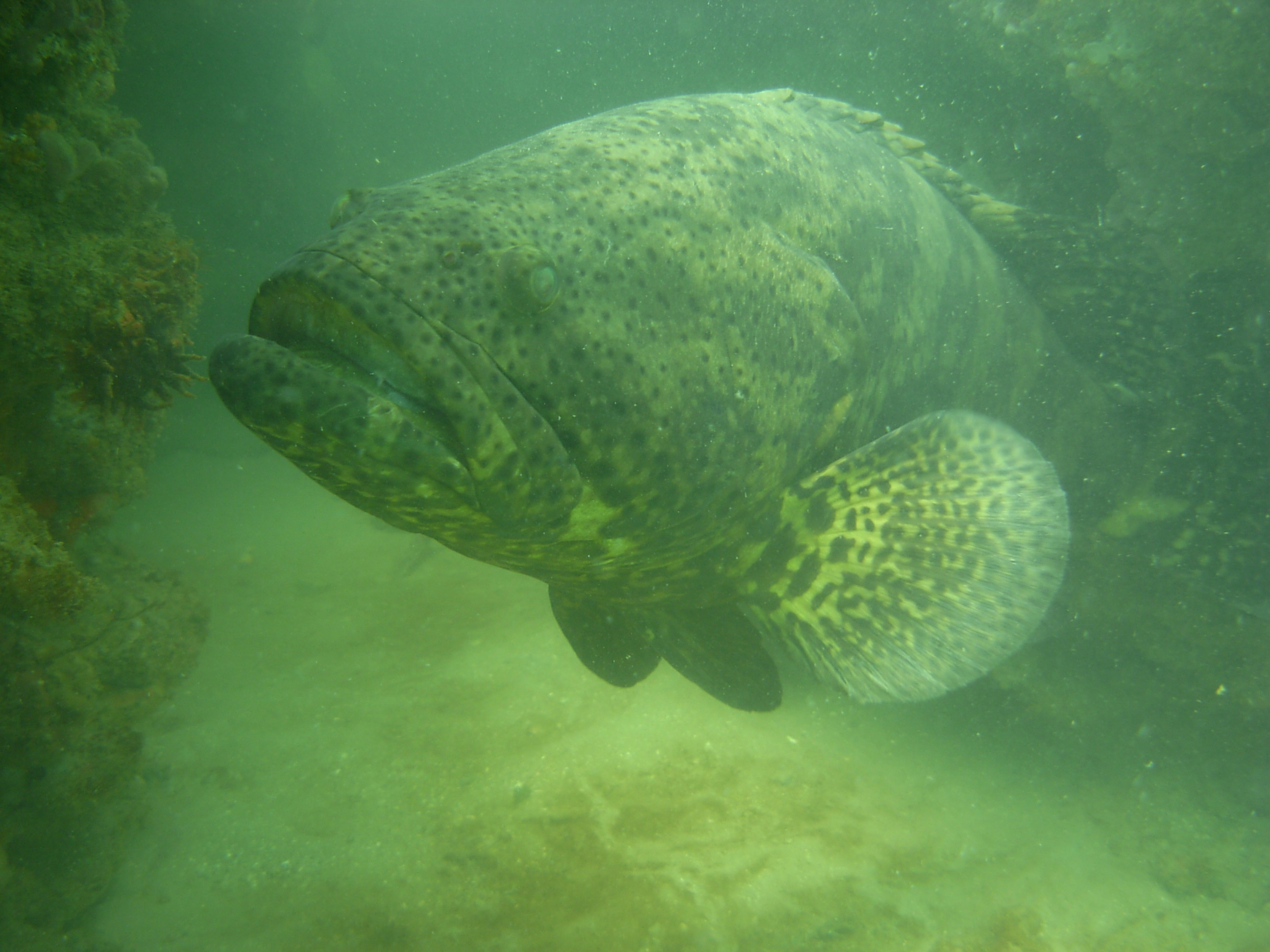
by Rick O'Connor | Mar 18, 2022
When you look over the species of sea basses and groupers from the Gulf of Mexico it is a very confusing group. Hoese and Moore1 mention the connections to other families and how several species have gone through multiple taxonomic name changes over the years – its just a confusing group.
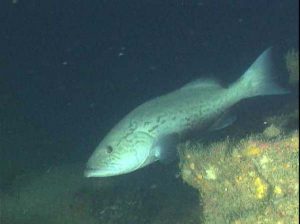
Gag grouper.
Photo: National Oceanic and Atmospheric Administration
But when you say “grouper” everyone knows what you are talking about, and everyone wants a grouper sandwich. This became a problem because what people were serving as “grouper” may not have been “grouper”. And as we just mentioned what is a grouper anyway? The families and genera have changed frequently. Well, this will probably get more technical than we want, but to sort it out – at least using the method Hoese and Moore did in 1977 – we will have to get a bit technical.
“Groupers” are in the family Serranidae. This family includes 34 species of “sea bass” type fish. Serranids differ from snappers in that they lack teeth on the vomer (roof of their mouths) and they differ from “temperate basses” (Family Percichthyidae) in that their dorsal fin is continuous, not separated into two fins. These are two fish that groupers have been confused with.
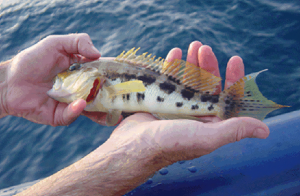
Banked Sea Bass.
Photo: National Oceanic and Atmospheric Administration.
We can subdivide the serranids into two additional groups. The “sea basses” have fewer than 10 spines in their dorsal fin. There are 10 genera and 18 species of them. They have common names like “bass”, “flags”, “barbiers”, “hamlets”, “perch”, and “tattlers”. They are small and range in size from 2 – 18 inches in length. Most are bottom reef fish with little commercial value for fishermen. Most are restricted to the tropical parts of the Atlantic basin but two are only found in the northwestern Gulf, one is only found in the eastern Gulf, and one has been found in both the Atlantic and Pacific. The biogeography of this group is very interesting. The same species found in both the Atlantic and Pacific suggest an ancient origin. The variety of serranid sea bass suggest a lot of isolation between groups and a lot of speciation.
The ”groupers” have 10 or more spines in their dorsal fin. There are two genera in this group. Those in the genus Epinephelus have 8-10 spines in their anal fin and have some canine teeth. Those in the genus Mycteroperca have 10-12 spines in their anal fin and lack canine teeth. Within these two genera there are 15 species of grouper, though the common names of “hind”, “gag”, “scamp” are also used. Most of these are found along the eastern United States and Gulf of Mexico. Five species are only found in the tropical parts of the south Atlantic region, five are also found across the Atlantic along the coast of Africa and Europe, and – like the “sea bass” two have been found in both the Atlantic and the Pacific. They range in size from six inches to seven feet in length. The Goliath Grouper can obtain weights of 700 pounds! Like the sea bass, groupers prefer structure and can live a great depths. Unlike sea bass they are heavily sought by commercial and recreational anglers and are one of the more economically important groups of fish in the Gulf of Mexico.

The massive size of a goliath grouper. Photo: Bryan Fluech Florida Sea Grant
One interesting note on this family of fish is that most are hermaphroditic. The means they have both ovaries (to produce eggs) and testes (to produce sperm). Sequential hermaphrodism is when a species is born one sex but becomes the other later in life. This is the case with most groupers, who are born female and become male later in life. However, the belted sand bass (Serranus subligarius) is a true hermaphrodite being able to produce sperm and egg at the same time – even being able to self-fertilize.
For many along the Florida panhandle, their biogeographic distribution and sex do not matter. It is a great tasting fish and very popular with anglers. For those with a little more interest in natural history of fish in our area, the biology and diversity of this group is one of the more interesting ones.
Reference
1 Hoese, H.D., Moore, R.H. 1977. Fishes of the Gulf of Mexico; Texas, Louisiana, and Adjacent Waters. Texas A&M Press. College Station TX. Pp. 327.
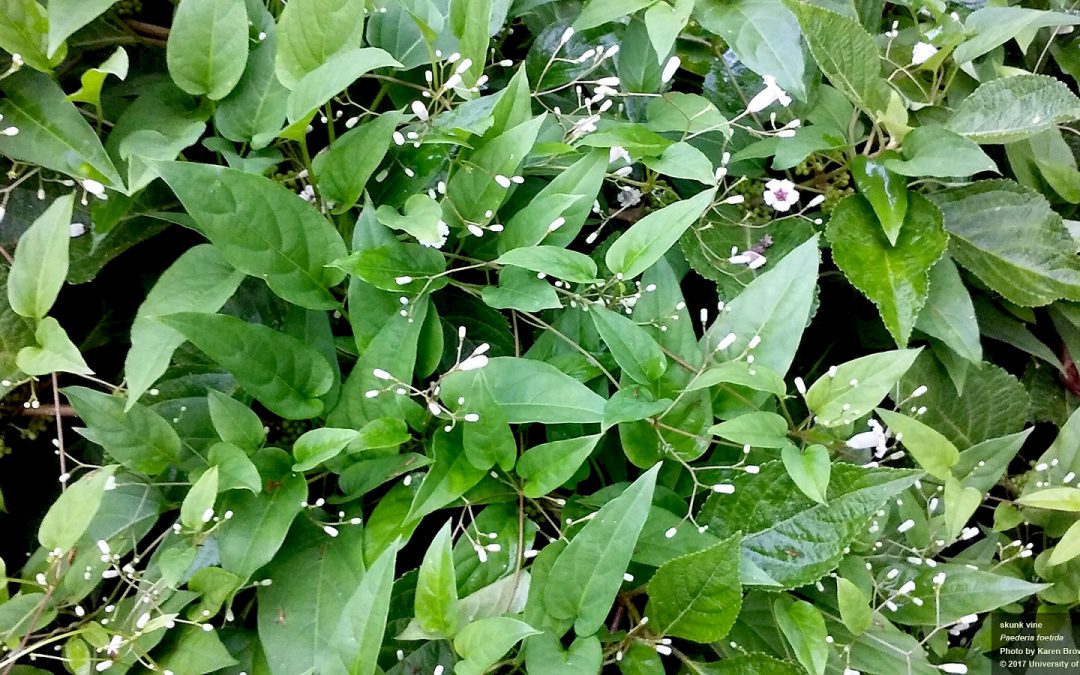
by Rick O'Connor | Mar 18, 2022
EDRR Invasive Species
Skunk Vine (Paederia foetida)

Skunk Vine
Photo: University of Florida
Define Invasive Species: must have ALL of the following –
- Is non-native to the area, in our case northwest Florida
- Introduced by humans, whether intentional or accidental
- Causing either an environmental or economic problem, possibly both
Define EDRR Species: Early Detection Rapid Response. These are species that are either –
- Not currently in the area, in our case the Six Rivers CISMA, but a potential threat
- In the area but in small numbers and could be eradicated
Native Range:
Eastern and southern Asia.
Introduction:
Around 1897 Skunk vine was introduced into Hernando County Florida as a possible fiber crop. It escaped cultivation and began to spread across central and north Florida.
EDDMapS currently list 1,252 records of skunk vine in the United States. Most are in central Florida but there are records in south and north Florida, as well as Louisiana, Texas, Georgia, South and North Carolina.
There 17 records in the Florida panhandle and 1 within the Six Rivers CISMA, that being in Santa Rosa County in the Blackwater State Forest.
Description:
This is a woody vine that can grow up to 30 feet. The vines are known to climb into the trees or grow along the ground. When crushed, the plant emits a foul odor, hence its name, and can be used to positively identify it. The leaves vary in shape but usually are heart shaped at the base, pointed at the tips, and have smooth margins. The flowers are small, light grayish pink in color, with red centers. The fruits are small and shiny brown. It can spread vegetatively or by seed.
Issues and Impacts:
This plant can survive in a variety of habitats including dense hardwood forest, pine forest, sandhills, floodplain forest, and marshes. Like kudzu and other vines, this plant will overgrow native plants on the ground and over trees. It can fill a tree canopy causing the collapse of it. It is a Category I invasive plant and a state noxious weed.
Management:
Care must be taken when trying to remove this plant. Stem fragments and seeds are easily lost when moving and can generate new plants. Extensive flooding may kill the plant, but it is known to live submerged for up to 190 days.
Skunk vine tends to invade open-disturbed areas within the forest. Mowing and tilling can help but are impractical in many cases. Studies on biological controlling insects are ongoing and show much promise.
Chemical control seems to be the most effective method at the moment, but single applications rarely complete the job. Triclopyr, with a surfactant, as a foliar spray has been effective. Glyphosate has also been effective. Care must be taken not to overspray onto other plants. Vines growing in trees should be pulled down and then sprayed to allow the herbicide to be pulled into the root system. The best time of year to do this is spring and summer.
Please report any sighting to www.EDDMapS.org. There are biologists who verify the photograph you send. It is important that we keep track of this EDRR species.
For more information on this EDRR species, contact your local extension office.
References
Paederia foetida. Skunk Vine. University of Florida Center for Aquatic and Invasive Plants. https://plants.ifas.ufl.edu/plant-directory/paederia-foetida/.
Early Detection and Distribution Mapping System (EDDMapS)
https://www.eddmaps.org/
Six Rivers CISMA
https://www.floridainvasives.org/sixrivers/

by Rick O'Connor | Mar 18, 2022
It is that time of year. The time of year when many head to their favorite nurseries to do their spring landscaping and gardening. Many of the plants sold at these locations are actually grown in more southern climates, where there are numerous invasive species of all sorts. Many of these invasive species have not made their way to the Florida panhandle but can hitchhiker on these plants when they are shipped up this way. Care should be taken when purchasing to make sure you are not bringing anything home other than the plant you want.

Nurseries provide native and nonnative plants.
The best management tool for invasive species is prevention. Across the country, particularly out west, there are survey stations at public lakes and reservoirs where state officials inspect boats and trailers when they arrive and when they leave the lake. There are hiking boot brushes at the entrance and exists to trails and active machine cleaning efforts after working in the field. Here in Florida, we do not pay as close attention to this. Machinery, boats, and plants are moved with little or no inspection. On any shipped plant could be an insect, slug, lizard, or frog that could eventually cause trouble for us. We are sure this is how the brown anole was introduced and we now getting reports of Cuban treefrogs in the panhandle.
Potential threats as EDRR species to our area include channeled apple snails, Cuban treefrogs, and greenhouse treefrog. With pond plants we need to be on the watch for several including Eurasian milfoil, water hyacinth, giant salvinia, and hydrilla. We also want to avoid purchasing and planting beach vitex, callery pear, coral ardisia, guinea grass, natalgrass, skunk vine, and swamp morning glory since they are all considered potential threats to the western panhandle.
If you have a question as whether a specific plant is invasive or not, you can visit the University of Florida’s Center for Aquatic and Invasive Plant website – https://plants.ifas.ufl.edu/.
The University of Florida IFAS Assessment website – https://assessment.ifas.ufl.edu/.
Or contact your county extension office.

by Rick O'Connor | Mar 11, 2022
Let’s begin by stating what a diamondback terrapin is. I have found many Floridians are not familiar with the animal. It is a turtle. A turtle in the family Emydidae which includes the pond turtles, such as cooters and sliders. The big difference between terrapins and the other emydid turtles is their preference for salt water. They are not marine turtles but rather estuarine – they like brackish water.
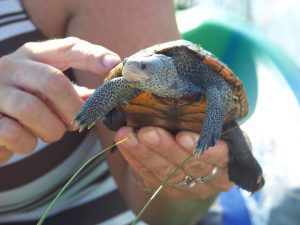
The diamond in the marsh. The diamondback terrapin.
Photo: Molly O’Connor
Their haunt are the salt marshes and mangroves of the state. Their range extends from Massachusetts down the east coast and covering all of the Gulf of Mexico over to Brownsville Texas. There are seven subspecies of the animal within that range. Five of those live in Florida and three only live in Florida. They are more abundant, and well known, in the Chesapeake Bay area where they are the mascot of the University of Maryland. In Florida they seem to be more secretive and hidden. Encounters with them are rare and there has been concern about their status for years. Though researchers are not 100% sure on their population size, it was felt that more conservation measures were needed.
Ten years ago, the issue with all turtles in the state was the illegal harvest for the food trade. All sorts of species were being captured and sent to markets overseas. The Florida Fish and Wildlife Conservation Commission (FWC) stepped in and set possession quotas on many species of Florida turtles. For terrapins, the number was two. For some, like the Suwannee Cooter, there was a no possession rule.
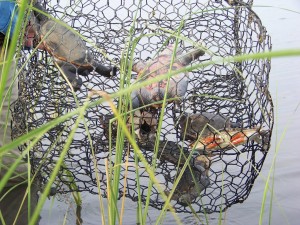
Drowned terrapins in a derelict crab trap in the Florida panhandle. (photo: Molly O’Connor)
There has also been concern with incidental capture of terrapins in crab traps. These turtles have been known to swim into the traps and drown. In the Chesapeake Bay area, they have found as many as 40 dead turtles in one trap. Not only is this bad for the turtles, but it is also bad for the crab fisherman because high numbers of dead turtles in the trap means no crabs. Studies began to develop some sort of excluder device that would keep terrapins out, but allow crabs in. Dr. Roger Wood developed a rectangle shaped wire excluder now called a By-Catch Reduction Device (BRD) that reduced the terrapin capture by 80-90% but had no significant effect on the crab catch. That was what they were looking for. This BRD has been required on crab traps up there for years.
What about Florida?
Studies using the BRD were also conducted here with the same results, but the BRD was not required. Incidental capture in crab traps does occur here but not to the extent it was happening in the Chesapeake and FWC wanted to hold off for more science before enacting the rule. BRDs were available for those who wanted them, but not required. This past December (2021) that changed.
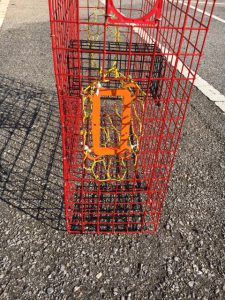
This orange plastic rectangle is a Bycatch Reduction Device (BRD) used to keep terrapins out of crab traps – but not crabs.
Photo: Rick O’Connor
In recent years there has been another issue with harvesting terrapins for the pet trade. With this, and other conservation concerns for this turtle, FWC developed a new rule for terrapins at their December 2021 meeting.
- The possession limit for terrapins has dropped from 2 to 0 – there is a no-take rule for this animal beginning March 1, 2022. Collection for scientific research will still be allowed with a valid collecting permit from the FWC. Those who currently have two or less terrapins in their possession as pets may keep them but must obtain a no cost personal possession permit to do so by May 31, 2022. Those who have terrapins within an education center may keep them but must obtain a no cost exhibit permit by May 31, 2022.
- Recreational crab traps will require the BRD device by March 1, 2023. You have a year. Those in the Pensacola area can contact me for these. I have a case of them I am willing to provide to the public.
Again, studies have shown that these BRDs do not significantly impact the crab catch. Crabs can turn sideways and still enter the traps. But reducing incidental capture of terrapins will hopefully increase their numbers in our state. For information on how to obtain the needed permits visit FWC.
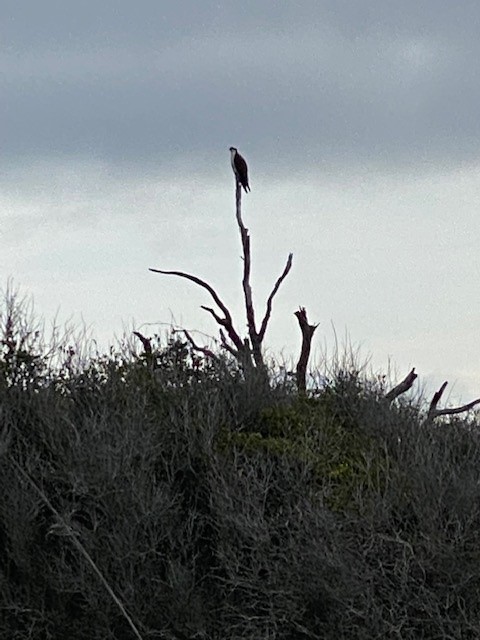
by Rick O'Connor | Mar 11, 2022
The month of March is the last of winter. For todays hike we returned to Gulf Islands National Seashore/Ft. Pickens where it was 63°F, overcast with a strong breeze from the northwest. A cold front is coming through to remind us that winter is not over yet. It was not 44°F as it was on our February hike but with the wind and cloud cover, it was a bit cool and not ideal for most wildlife to be out. But the ospreys were…
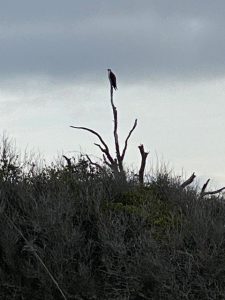
Osprey perched.
Photo: Rick O’Connor
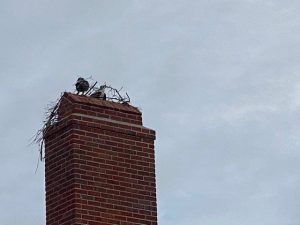
An osprey pair building a nest on the chimney of the ranger station at Ft. Pickens.
Photo: Rick O’Connor
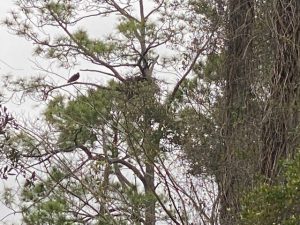
Another osprey pair with a nest in a large pine.
Photo: Rick O’Connor
They were everywhere. Building nests in live pines, dead snags, platforms built just for this, and on the chimney of the ranger station. Their sounds were everywhere – it is breeding season for them. The great blue herons were still nesting, we saw them first in January, but there are still a few around. American egrets were out as were numerous mourning doves. As with the colder February day, it was primarily bird action right now. I did see evidence of armadillos, and would guess other mammals were on the move, but did not see evidence of any others. The reptiles and amphibians are still missing – but should not be for long.
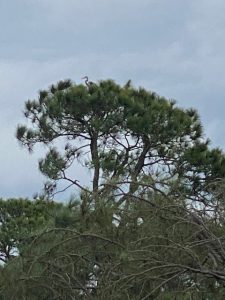
The herons began nesting in January. Some are still there.
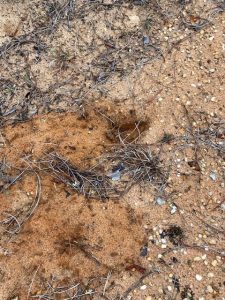
Evidence of armadillos digging.
The plant I know as beach heather, many call false rosemary, and has the scientific name Conradina, was in full bloom. After the hollies of the Christmas season, these are the plants I often see bloom first. Though I have seen bees around my home already, and wasps, I did not see/hear any insect movement this morning.
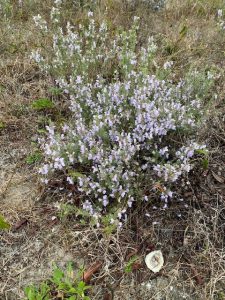
Beach heather (false rosemary) is one of the first plants to bloom on our islands.
The north beach (Pensacola Bay) was rough due to the northwest wind. It was difficult to see if anything was moving around in the shallows. There were a lot of shells on the shore. Two particularly caught my eye. The Florida Fighting Conch was pretty abundant, more than normal – and there were several scallops shells. There are two species locally, the calico scallop (often found in the Gulf) and the bay scallop (the estuarine version and the one of “scalloping” fame). Calcio scallops are often pinkish in color and often with spots. The bay scallop is usually gray in color. Those I saw this morning were all bleached white but, based on other variety of shells in the mix, I am thinking these were calcio scallops.
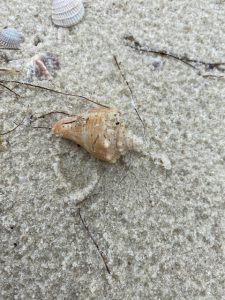
There were several Florida Fighting Conch shells on the beach this month.
There was very little marine debris today and no tracks of any kind seen. There was only one lone pelican spotted, maybe due to the high winds they settled somewhere else. Maybe they have moved off to smaller islands for breeding themselves, I am not sure.
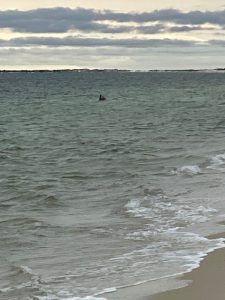
We only saw this one lone pelican today.
Though the wildlife has been more restricted to birds at the moment, the birding is excellent right now and the beach has relatively few people – it is a great time to take a hike out there.
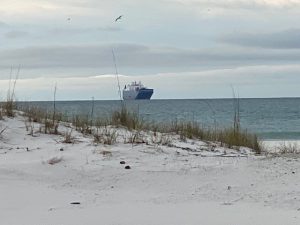
This large tanker awaits its turn to enter Pensacola Bay.
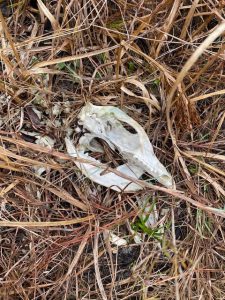
This skull found along the side of the side of the road is believed to be a raccoon.
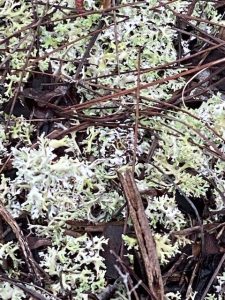
Lichen is an organism that is a partnership between algae and fungus. They were a brilliant white-green this month.
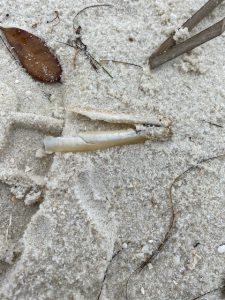
Razor clam shells are quite common along the shoreline.
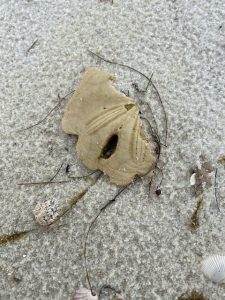
Sand dollars are not as common on the bay side of the island but there were several today.
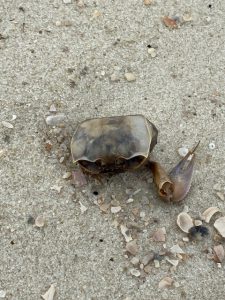
The remains of a ghost crab.
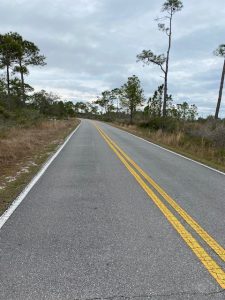
Believe it or not, walking along the road is a great spot to find wildlife.



























